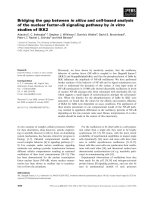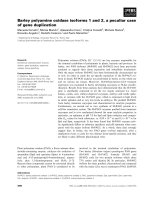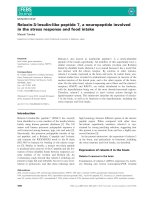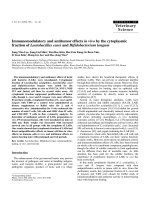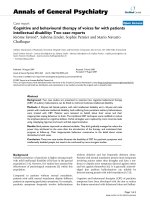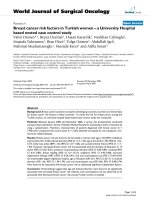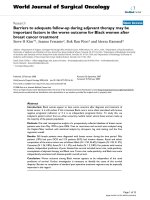báo cáo khoa học:" Barriers towards insulin therapy in type 2 diabetic patients: results of an observational longitudinal study" pps
Bạn đang xem bản rút gọn của tài liệu. Xem và tải ngay bản đầy đủ của tài liệu tại đây (188.13 KB, 6 trang )
RESEARC H Open Access
Barriers towards insulin therapy in type 2
diabetic patients: results of an observational
longitudinal study
Norbert Hermanns
1*†
, Marina Mahr
1†
, Bernd Kulzer
1†
, Sören E Skovlund
2†
, Thomas Haak
1†
Abstract
Background: The course of barriers towards insulin therapy was analysed in three different groups of type 2
diabetic patients. This observational longitudinal study surveyed a three-month follow-up.
Methods: Participants in this study totalled 130 type 2 diabetic patients. The first subgroup was on insulin therapy
at baseline (g roup 1: n = 57, ag e 55.6 ± 8.7 yrs, disease duration 12.7 ± 7.2 yrs, HbA1c 8.5 ± 1.6%) and remained
on insulin at follow-u p. Of an initial 73 insulin-naïve patients, 44 were switched to insulin therapy (group 2: age
58.1 ± 6.8 yrs, disease duration 7.7 ± 5.0 yrs, HbA1c 9.1 ± 1.7%) and 29 patients remained on an oral regimen
(group 3: age 52.7 ± 10.7 yrs, disease duration 5.3 ± 4.6 yrs, HbA1c 8.3 ± 1.4%). Barriers towards insulin therapy
were measured using the Insulin Treatment Appraisal Scale (ITAS). As generic instruments of health related quality
of life patients completed also the Problem Areas of Diabetes Questionnaire (PAID), the WHO-5 Well-Being Scale
(WHO-5), the Centre for Epidemiologic Studies Depression Scale (CES-D) and the Trait Version of the State Trait
Anxiety Inventory (STAI) at baseline and at three-month follow-up.
Results: At the three-month follow-up, HbA1c had improved in all three groups (7.7 ± 1.2% vs. 7.1 ± 1.1% vs. 6.7 ±
0.8%). The course of negative appraisal of insulin therapy was significantly different in the three groups (p > .003):
the ITAS score increased in patients remained on oral antidiabetic drugs (51.2 ± 12.2 to 53.6 ± 12.3), whereas it
decreased in patients switched to insulin therapy (49.2 ± 9.8 to 46.2 ± 9.9) or remained on insulin treatment
(45.8 ± 8.3 to 44.5 ± 8.0). Diabetes-related distress, trait anxiety, and well-being, showed a similar course in all three
groups. The depression score improved significantly in patients switched to insulin treatment compared with
patients remaining on insulin therapy.
Conclusions: In summary, this study suggests that a negative appraisal of insulin treatment is modifiable by the
initiation of insulin therapy. This finding indicate s that barriers to insulin are a rather temporary than a stable
phenomenon.
Background
Poor glycaemic control is a risk factor for the develop-
ment of diabetes-specific complications in diabetic
patients. Many type 2 diabetic patients require insulin
therapy after several years of disease duration in order
to maintain good glycaemic control and prevent compli-
cations. But many type 2 diabetic patients do not receive
insulin therapy in a timely manner because of a negative
appraisal of this treatment option [1].
Patients’ negative attitudes towards starting insulin
therapy are based on their beliefs that the need for insu-
lin therapy indicates a greater severity of the disease and
proves their failure to self-manage the diabetes ade-
quately. Worries about painful injections and the risk of
severe side effe cts such as hypoglycaemia are also very
common among type 2 diabetic patients. Some type 2
diabetic patients fear that insulin therapy is too difficult
to manage in everyday life and is associated with social
stigma [2]. In the literature the above-described phe-
nomenon is called psychological insulin resistance [3,4].
* Correspondence:
† Contributed equally
1
Research Institute of the Diabetes Academy Bad Mergentheim, Bad
Mergentheim, Germany
Full list of author information is available at the end of the article
Hermanns et al. Health and Quality of Life Outcomes 2010, 8:113
/>© 2010 Herm anns et al; licensee BioMed Central Ltd. This is an Open Access article distributed under the terms of the Creative
Commons Attribution License ( which permits unrestri cted use, distribution, and
reproduction in any medium, provided the original work is properly cited.
Cross-sectional data demonstrate that barriers to insu-
lin therapy are higher in insulin-naïve type 2 diabetic
patients than in insulin-treated type 2 diabetic patients
[2,5]. However, from cross-sectional analysis it is diffi-
cult to decide whether barriers to insulin therapy exists
mainly temporary and reduce by the experience of insu-
lin therapy or whether it is a selection factor caused by
the circumstance that only type 2 diabetic patients with
a more positive appraisal of insulin therapy will accept
this treatment option. From a clinical perspective, each
explanation would require a different therapeutic
approach. In the first case, diabetes education or better
instructions about i nsulin treatment could be powerful
tools to help type 2 diabetic patients coping better with
the challenges of insulin therapy and changing their
negative appraisal of this treatment option. In the latter
case, new types of insulin or different forms of insulin
applications (e.g. inhaled insulin) might be helpful to
reduce barriers to insulin therapy and encourage a
greater proportion of type 2 diabetic patients to use this
powerful treatment option. Thus, clearly, longitudinal
data on the course of barriers towards insulin therapy
after the initiation of insulin therapy are needed to
address these issues.
It can also be expected that negative appraisal of insu-
lin therapy in combination with a need for initiation of
insulin therapy has a negative impact on other quality of
life aspects such as diabetes-related distress, symptoms
of depression and anxiety, and psychological well-being
among diabetic patients [2,5].
In this observational study we compared the barriers
to insulin therapy and more generic quality of life
aspects among insulin-trea ted and insulin-naïve type 2
diabetic patients who had poor glycaemic control at
baseline and three months after an intensification of dia-
betes treatment. In a subgroup of insulin-naïve type 2
diabetic patients, insulin therapy was initiated.
Methods
Participants in this observational l ongitudinal study
were type 2 diabetic patients who were referred by
general practitioners to practices of diabetologis ts or to
the Diabetes Centr e Mergentheim. The main reason
for referral was unsatisfactory glycaemic control
according to the guideline of the German Diabetes
Association [6].
Inclusion criteria of the study
• Poor glycaemic control ( HbA1c > 6.5% or blood
glucose excursions)
• Age 18-75 years
• Ability to understand the German language
• Informed consent given
Exclusion criteria
• Severe life-threatening disease according to the
judgement of a diabetologist
• Guardianship
The study was approved by an ethics committee. All
patients declared informed consent to participate in this
observational study.
Measures
Appraisal o f insulin therapy was measured by the Insu-
lin Treatment Appraisal Scale (ITAS) [2]. The ITAS,
which was designed to assess attitudes towards insulin
treatment in type 2 diabetic patients, consists of 20
items. Subjects are requested to indicate on a 5-point
Likert scale to what extent they agree with each state-
ment, from “strongly disagree” to “strongly agree”.The
ITAS is a two-dimensional instrument, with “appraisal
of insulin therapy ” as a single underlying construct. The
instrument permits the calculation of a total score a nd
two sub scal e scores that measure positive (4 items) and
negative (16 items) attitudes towards insulin treatment.
Example items representing a positive attitudes towards
insulin therapy are: “Taking insulin helps to prevent
complications of diabetes” or “Taking insulin helps to
maintain good contro l of blood glucose”. I tems like
“Taking insulin means I have failed to manage my dia-
betes with diet and tablets” or “Managing insulin injec-
tions takes a lot of time and energy” are examples
repre senting a negative attitude towards insulin therapy.
The psychometric properties of the ITAS were con-
firmed recently. The reliability of the total scale was
Cronbach’s a = .89 (neg ative appr aisal scale Cronbach’s
a = .90, positive appraisal scale Cronbach’s a = .68) and
can be regarded as highly satisfactory [2].
As generic measures of emoti onal well-being and
emotional distress, established depression-, anxiety-, and
well-being scales were used. Patients completed the Ger-
man version of the Centre for Epidemiologic Studies
Depression Scale (CES-D) [7,8] to assess depressive
symptoms. The CES-D has a scale range between 0 and
60; higher scores indicate higher levels of depressive
symptoms. Anxiety symptoms were measured by the
trait version of the State-Trait-Anxiety-Inventory (STAI)
[9,10]. This questionnaire has a scale range between 20
and 80. Higher scores on the Trait-STAI represent
higher levels of trait anxiety symptoms. T he WHO-5
well-being scale was used to measure well-being [11].
The WHO-5 contains five items, which are all positively
worded. A maximum score of “25” indicates optimal
well-being, whereas a score of “0” indicates minimal
well-being. Diabetes-specific distress was assessed by the
German version of the Problem Area s in Diabetes Scale
Hermanns et al. Health and Quality of Life Outcomes 2010, 8:113
/>Page 2 of 6
(PAID) [12]. The PAID questionnaire consists of 20
items. Each item can be rated on a 5-point Likert scale
ranging from “0” (no problem) to “4” (serious problem).
According to the recommendation o f the test’s authors,
the PAID scores were transformed to a 0-100 scale, with
higher scores indicating more serious emotional pro-
blems. The original scale has proved its validity and
reliability [13].
Glycaemic control was measured by HbA1c through
use of high pressure liquid chromatography. The normal
range of HbA1c is 4.1% - 6.1%.
Statistical analysis
Continuous data were analysed by use of parametric
methods, and categorical data were analysed by Chi-
Square tests. For comparisons of three groups, analyses
of variance were used. The analysis of differences
between baseline and follow-up measurements was
adjusted for baseline values through use of covariance
analysis (ANCOVA). Post hoc tests were performed in
case of an overall significant effect.
Results
Baseline characteristics
Participants in this study totalled 130 type 2 diabetic
patients, of whom 73 were insulin-naïve and 57 were
insulin-treated. As s hown in table 1 insulin-treated and
insulin-naïve patients were of a comparable relatively
young age and had a similar gender distribution, with
fewer women than men. Glycaemic control was rather
poor in both groups, as could be expected from the inclu-
sion criteria. Insulin-naïve patients demonstrated a signif-
icantly shorter disease duration and had significantly
fewer diabetes-associated complications. As could be
expected from previous findings, insulin-naïve patients
had a significantly more negative appraisal of insulin
therapy than patients who alre ady were being treated
with insulin. The insulin-treated patients demonstrated a
tendency towards higher depression scores (p < .10).
On the rema ining scales, insulin-treated type 2 diabetic
patients had higher scores, a result that indicates a lower
health related quality of life. However, these differences
failed to reach significance level.
Of the patients receiving insulin therapy, 27 (47.4%)
had an insulin monotherapy and 30 patients received a
combination therapy of insulin and oral antidiabetic med-
ication. The two subgroups did not differ with regard to
baseline HbA1c (8.6 ± 1.9% vs. 8.5 ± 1.5%, p = .74).
Follow up results
Table 2 shows the baseline characteristics of patients
switched to insulin vs. patien ts who remained on treat-
ment with oral antidiabetic agents. Patients who were
switched to insul in therapy were significant ly older, had
a significantly longer diabetes duration, and had more
diabetes complications than patients who remained on
an oral diabetes regimen. Patients who were switched to
insulin therapy had a higher HbA1c level than patients
who remained on treatment with antidiabetic drugs. As
reported in table 3 there were no significant differences
on the ITAS total score between patients who remained
on an oral regimen and patients who were switched to
insulin therapy (pairwise comparisons between these
two groups p = .674).
All patients who were on insulin therapy at baseline
remained on this treatment. The HbA1c level in the
patients remaining on insulin treatment fell significantly.
Interestingly, this outcome was achieved by increasing
the proportion of patients who received a combination
treatment of oral antidiabetic agents and insulin. The
Table 1 Baseline characteristics
Insulin-naïve type 2 diabetic patients (n = 73) Insulin-treated type 2 diabetic patients (n = 57) p
Mean age ± SD (yrs) 56.0 ± 8.9 55.6 ± 8.7 .824
% female (number) 31.5 (23) 38.6 (22) .399
Mean disease duration ± SD (yrs) 6.8 ± 5.0 12.7 ± 7.2 < .001
Mean HbA1c ± SD (%) 8.8 ± 1.6 8.5 ± 1.6 .455
Mean BMI ± SD (kg/m
2
) 32.6 ± 6.0 35.7 ± 7.9 .0.17
# of complications
1
0.6 ± 1.0 1.4 ± 1.3 < .001
Mean ITAS ± SD (total score) 50.0 ± 10.8 45.8 ± 8.3 .013
Mean negative ITAS ± SD 41.3 ± 10.4 37.4 ± 7.6 .016
Mean positive ITAS ± SD 9.9 ± 2.3 9.4 ± 1.9 .175
Mean PAID ± SD 31.4 ± 18.3 28.2 ± 14.1 .257
Mean WHO-5 ± SD 14.7 ± 6.3 12.9 ± 6.4 .115
Mean CES-D ± SD 14.4 ± 9.7 17.8 ± 10.9 .072
Mean Trait Anxiety ± SD 39.9 ± 11.3 41.6 ± 8.4 .334
1
Retinopathy, nephropathy, diabetic neuropathy, diabetic foot syndrome, coronary heart disease, stroke, arterial occlusive disease
Hermanns et al. Health and Quality of Life Outcomes 2010, 8:113
/>Page 3 of 6
Table 2 Baseline characteristics of patients switched to insulin vs. patients remained insulin naïve.
Remained insulin-naïve
n=29
Switched to insulin treatment
n=44
p
Mean age ± SD (yrs) 52.7 ± 10.7 58.1 ± 6.8 .010
% female (number) 31.0 (9) 31.8 (14) .945
Mean disease duration ± SD (yrs) 5.3 ± 4.6 7.7 ± 5.0 .040
Mean HbA1c ± SD (%) 8.3 ± 1.4 9.1 ± 1.7 .027
# of complications
1
0.2 ± 0.5 0.9 ± 1.2 .002
1
Retinopathy, nephropathy, diabetic neuropathy, diabetic foot syndrome, coronary heart disease, stroke, arterial occlusive disease
Table 3 Baseline and follow-up results in the three different treatment groups
Patients who remained insulin-
naïve
Patients switched to insulin
treatment
Patients who remained on insulin
therapy
p between
groups
HbA1c (%)
Baseline 8.3 (± 1.4) 9.1 (± 1.7) 8.6 (± 1.7) .078
Endpoint 6.7 (± 0.8) 7.1 (± 1.1) 7.7 (± 1.2) < .001
c
Change -1.6 (± 1.7)* -1.8 (± 1.8)* -0.9 (± 1.7)* < .001
1bc
BMI (kg/m
2
)
Baseline 32.9 (± 6.5) 32.4 (± 5.8) 35.7 (± 7.9) .051
Endpoint 31.2 (± 6.6) 31.3 (± 5.2) 35.0 (± 7.9) .010
bc
Change -1.7 (± 1.5)* -1.1 (± 1.9)* -0.7 (± 2.6)* .054
1
ITAS (total score)
Baseline 51.2 (± 12.2) 49.2 (± 9.8) 45.8 (± 8.3) .040
c
Endpoint 53.6 (± 12.3) 46.2 (± 9.9) 44.5 (± 8.0) < .001
bc
Change 2.4 (± 14.8)
ns
-3.0 (± 7.0)* -1.3 (± 8.0)
ns
.003
1ac
Negative ITAS
Baseline 41.8 (± 12.2) 41.0 (± 9.1) 37.4 (± 10.4) .063
Endpoint 43.4 (± 11.8) 37.9 (± 8.7) 35.7 (± 7.4) .002
bc
Change 1.6 (± 15.0)
ns
-3.1 (± 6.5)* -1.7 (± 7.3)
ns
.006
1ac
Positive ITAS
Baseline 10.4 (± 2.5) 9.5 (± 2.2) 9.4 (± 1.9) .098
Endpoint 11.0 (± 2.8) 9.4 (± 2.2) 9.6 (± 2.0) .008
bc
Change 0.6 (± 3.0)
ns
-0.1 (± 2.2)
ns
0.2 (± 2.4)
ns
.042
1ac
PAID
Baseline 27.7 (± 17.8) 33.8 (± 18.4) 28.2 (± 14.1) .166
Endpoint 21.8 (± 13.9) 26.5 (± 15.6) 24.6 (± 16.9) .384
Change -5.9 (± 15.8)
ns
-7.3 (± 14.9) * -3.6 (± 15.1)
ns
.285
1
WHO-5
Baseline 16.4 (± 6.0) 13.6 (± 6.3) 12.9 (± 6.4) .056
Endpoint 16.7 (± 5.6) 15.6 (± 5.8) 13.9 (± 6.0) .129
Change 0.3 (± 5.7)
ns
2.0 (± 4.9) * 1.0 (± 5.7)
ns
.389
1
CES-D
Baseline 11.7 (± 8.2) 16.1 (± 10.2) 17.8 (± 10.9) .039
c
Endpoint 10.8 (± 7.9) 11.9 (± 9.8) 16.4 (± 9.8) .019
Change -0.9 (± 7.1)
ns
-4.2 (± 6.0) * -1.4 (± 8.5)
ns
.045
1b
Trait Anxiety
Baseline 37.7 (± 9.7) 41.3 (± 12.0) 41.6 (± 8.4) .227
Endpoint 36.4 (± 8.3) 40.2 (± 10.6) 40.7 (± 9.9) .138
Change -1.3 (± 5.9) ns -1.1 (± 8.2) ns -0.9 (± 7.2) ns .622
1
Values are means (± SD);
1
adjusted for baseline;
a
= p < .05 between “patients who remained insulin-naïve” and “patients switched to insulin treatment";
b
= p < .05 between “patients switched to insulin treatment” and “patients who remained on insulin therapy";
c
= p < .05 between “patients who remained
insulin-naïve” and “patients who remained on insulin therapy"; * significant within comparison (p < .05),
ns
non-significant within comparison (p > .05)
Hermanns et al. Health and Quality of Life Outcomes 2010, 8:113
/>Page 4 of 6
proportion of patients on combination therapy with oral
antidiabetic agents and insulin rose from 47.4% to 71.9%
(McNemar test p < .05). The mean daily insulin dose
decreas ed from 0.88 ± 0.62 IU/kg to 0. 63 ± 0.44 IU/kg
(p < .01). Body weight was also slightly, but significantly
reduced.
Of the patients on oral antidiabetic medication at
baseline, 44 (60.3%) were switched to insulin therapy.
The decision was made by the treating diabetologist,
based on clinical judgement. No patient in this study
rejected the insulin therapy option.
The patients switched to insulin therapy received, on
average, 0.28 ± 0.23 IU/kg and injected insulin 1.9 ± 1.4
times a day on average. HbA1c improved significantly in
these patients. Interestingly, BMI was also significantly
reduced (see table 3).
In the patients who remained on oral antidiabetic
medication, HbA1c also improved significantly.
Although in all t hree groups there was a significant
within effect on HbA1c in the follow-up period, the
improvement of glycaemic control wa s significantly
greater in patients who were switched to insulin therapy
or remained on an oral regimen than in patients who
remained on insulin therapy.
Barriers towards insulin therapy developed signifi-
cantly different among the three groups. In patients who
remained on an oral regimen, the negative appraisal of
insulin thera py increased, whereas in patient s who were
switched to insulin therapy the negative appraisal of
insulin therapy was reduced to the level of patients who
remained on insulin therapy.
The same pattern of change was present regarding the
subscale of negative appraisal of insulin treatment. In
the subscale of positive appraisal of insulin therapy the
scores were rather stable in all three patient groups.
In patients on an oral regimen at baseline, there was a
remarkable improvement of diabetes-related distress
regardless of whether those patients remained on an oral
regimen or were switched to insulin treatment. Patients
who remained on insulin treatment improved slightly.
However, there was no significant overall change in dia-
betes-related distress in the three treatment groups.
General well-being improved slightly in all three
groups, but there was no significant difference among
these patients groups.
Depressive symptoms were significantly reduced in
patients who were switched to insulin therapy compared
with patients who remained on insulin therapy.
Ther e was no si gnificant effect on trait anxiety during
the follow-up period.
Discussion
At baseline, more barriers to insulin therapy were
demonstrated by insulin-naïve type 2 d iabetic patients
compared with insulin-treated type 2 diabetic patients.
This result is in line with previous findings of cross-sec-
tional studies [2-5]. How ever, cross-sectional data are
difficult to interpret. It is difficult to decide whether the
lower level of negative appraisal of insulin therapy
among insulin-treated type 2 diabetic patients is a con-
sequence of adaptation to the demands of insulin treat-
ment or whether a selection bias is mainly responsible
for this finding. Patients who have a less negative
appraisal of insulin treatment might be more likely to
accept insulin treatmen t than patients who have a more
objections against this treatment option.
This study provides longitudinal data about the course
of negative appraisal of insulin in insulin-naïve and insu-
lin-treated type 2 diabetic patients. Of the insulin-naïve
patients, 60% were switched to insulin treatment. At
baseline, those type 2 diabetic patients who were
switched to insulin therapy and those patients who
remained on an oral regimen did not differ with regard
to their appraisal of insulin treatment. Thus a selection
bias, meaning that only patients who had lower barrie rs
to insulin therapy were switched to insulin treatment,
seems unlikely.
At the three-month follow up, it could be demon-
strated clearly that barriers to insulin therapy increased
in patients who remained on an oral regimen, whereas
negative appraisal of insulin treatment was reduced in
patients who were switched to insulin therapy. The
negative appraisal of insulin treatment in patients who
were switched to insulin therapy was reduced to the
level of patients already treated with insulin.
Therefore, it seems reasonab le to assume that patients
who are exposed to insulin therapy acquire new skills
regarding how to handle insulin and change their
appraisal of this treatment opt ion. These patients may
accommodate to this treatment alternative and reduce
their barriers to insulin therapy.
One strength of this study is that in addition to ne ga-
tive appraisal of insulin treatment, a broad assessment
of more generic psychological variables such as well-
being, diabetes-related distress, anxiety, and depressive
symptoms were longitudinally assessed. Except for a sig-
nificant effect on depression, there was no specific
impact of the subsequent diabetes treatment on anxiety
symptoms, diabetes-related distress, or psychological
well-being. These findings might indicate that negative
attitudes regarding insulin treatment is a rather specific
barrier to this treatment option and is not strongly asso-
ciated with general aspects of health related quality of
life. This idea is corroborated by the f inding that
patients who rem ained on an oral regimen had the low-
est depression scores at baseline as well as at follow-up,
although their negative appraisal of insulin treatment
increased.
Hermanns et al. Health and Quality of Life Outcomes 2010, 8:113
/>Page 5 of 6
Patients who remained on insulin treatment and
patients who were s witched to insulin treatment had
more late complications than insulin-naïve patients. It is
well known that complications of diabetes are associated
with depr ession [14,15]. Most patients who were
switched to insulin treatment experienced remarkably
improved glycaemic control. This outcome might have
had a spec ific antidepressi ve effect , which could explain
the significantly greater reduction of depressive symp-
toms in this group.
There are also some limitations of this study. The
study is observational, meaning that the groups were
not randomised. The decision who remained on an oral
regimen and who was switched to insulin was at the dis-
cretion of the clinicians. Although this clinical judge-
ment proved to b e effective with regard to the
glycaemic control achieved during follow-up, a sel ection
bias cannot be excluded.
Thesamplesizeisrathersmall;thusalackofpower
could be responsible for the f act that the effect of the
diabetes treatment at follow-up could n ot be assessed
with respect to more generic variables such as anxiety,
diabetes-related distress, and well-being.
The follow-up period is rather short; longer follow-up
period is needed to evaluate if reducing barriers to insu-
lin therapy is maintained, further reduced or increased
over time.
Conclusions
Nevertheless, in summary, this stu dy demonstrates that
negative appraisal of insulin treatment is modifiable by
the initiation of insulin therapy. This finding indicates
that barrier s to insulin treatment is a benign, temporary
phenomenon instead of an unvarying patient character-
istic. Future studies should address if identifying and
addressing patients concerns about insulin therapy can
help to improve long-term adaptation to insulin therapy.
Acknowledgements
The authors thank all study centres involved in this study: Dr. Gerhard
Eberlein, Bayreuth, Dr. Helmut Hasche†, Bad Kissingen, Dr. Rosina Herold-
Beifuss, Bad Staffelstein, Prof. Dr. Hans-Dieter Janisch, Erlangen, Dr. Dorothea
Reichert, Landau and the Diabetes Zentrum Mergentheim, Bad
Mergentheim.
Author details
1
Research Institute of the Diabetes Academy Bad Mergentheim, Bad
Mergentheim, Germany.
2
Novo Nordisk, Copenhagen, Denmark.
Authors’ contributions
NH participated in the design of the study, performed the statistical analysis
and drafted the manuscript. MM participated in the design of the study and
collected the data. BK participated in the design of the study and helped to
draft the manuscript. SES has been involved in revising the manuscript
critically for important intellectual content. TH participated in the design of
the study and coordination and helped to draft the manuscript. All authors
read and approved the final manuscript.
Competing interests
This study was supported by an unrestricted grant of Novo Nordisk. NH and
BK are members of the German DAWN advisory board supported by Novo
Nordisk.
Received: 2 March 2010 Accepted: 4 October 2010
Published: 4 October 2010
References
1. Kulzer B, Hermanns N, Scholze A, Kubiak T, Haak T: Concerns about insulin
therapy in patients with type 2 diabetes (Abstract). Diabetes 2004, 53:
A438-A439.
2. Snoek FJ, Skovlund SE, Pouwer F: Development and validation of the
insulin treatment appraisal scale (ITAS) in patients with type 2 diabetes.
Health Qual Life Outcomes 2007, 5:69.
3. Polonsky WH, Fisher L, Guzman S, Villa-Caballero L, Edelman SV:
Psychological insulin resistance in patients with type 2 diabetes: the
scope of the problem. Diabetes Care 2005, 28:2543-2545.
4. Peyrot M, Rubin RR, Lauritzen T, Skovlund SE, Snoek FJ, Matthews DR,
Landgraf R, Kleinebreil L: Resistance to insulin therapy among patients
and providers: results of the cross-national Diabetes Attitudes, Wishes,
and Needs (DAWN) study. Diabetes Care 2005, 28:2673-2679.
5. Petrak F, Stridde E, Leverkus F, Crispin AA, Forst T, Pfutzner A: Development
and validation of a new measure to evaluate psychological resistance to
insulin treatment. Diabetes Care 2007, 30:2199-2204.
6. Matthaei S, Bierwirth R, Fritsche A, Gallwitz B, Haring HU, Joost HG,
Kellerer M, Kloos C, Kunt T, Nauck M, Schernthaner G, Siegel E, Thienel F:
Medical antihyperglycaemic treatment of type 2 diabetes mellitus:
update of the evidence-based guideline of the German Diabetes
Association. Exp Clin Endocrinol Diabetes 2009, 117:522-557.
7. Radloff LS: The CES-D scale: A self report depression scale for research in
the general population. Applied Psychological Measurement 1977, 3:385-401.
8. Hautzinger M, Bailer J: Allgemeine Depressions-Skala Göttingen, Hogrefe
1993.
9. Spielberger CD, Gorsuch RL, Lushene RE: STAI-manual for the State-trait
anxiety inventory, self-evaluation questionnaire Palo Alto, Calif., Consulting
Psychologists Press 1970.
10. Laux L, Glanzmann P, Schaffner P, Spielberger D: Das State-Trait-
Angstinventar. Theoretische Grundlagen und Handanweisung Beltz, Weinheim
1981.
11. Bech P, Olsen LR, Kjoller M, Rasmussen NK: Measuring well-being rather
than the absence of distress symptoms: a comparison of the SF-36
Mental Health subscale and the WHO-Five Well-Being Scale. Int J
Methods Psychiatr Res 2003, 12:85-91.
12. Hermanns N, Kulzer B, Krichbaum M, Kubiak T, Haak T: How to screen for
depression and emotional problems in patients with diabetes:
comparison of screening characteristics of depression questionnaires,
measurement of diabetes-specific emotional problems and standard
clinical assessment. Diabetologia 2006, 49:469-477.
13. Welch GW, Jacobson AM, Polonsky WH: The Problem Areas in Diabetes
Scale. An evaluation of its clinical utility. Diabetes Care 1997, 20:760-766.
14. Pouwer F, Beekman ATF, Nijpels G, Snoek FJ, Kostense PJ, Heine RJ,
Deeg DJH: Rates and risks for co-morbid depression in patients with
type 2 diabetes mellitus: results of a community based study.
Diabetologia 2003, 46:892-898.
15. de Groot M, Anderson RJ, Freedland KE, Clouse RE, Lustman PJ: Association
of depression and diabetes complications: a meta-analysis. Psychosomatic
Medicine
2001, 63:619-630.
doi:10.1186/1477-7525-8-113
Cite this article as: Hermanns et al.: Barriers towards insulin therapy in
type 2 diabetic patients: results of an observational longitudinal study.
Health and Quality of Life Outcomes 2010 8:113.
Hermanns et al. Health and Quality of Life Outcomes 2010, 8:113
/>Page 6 of 6


